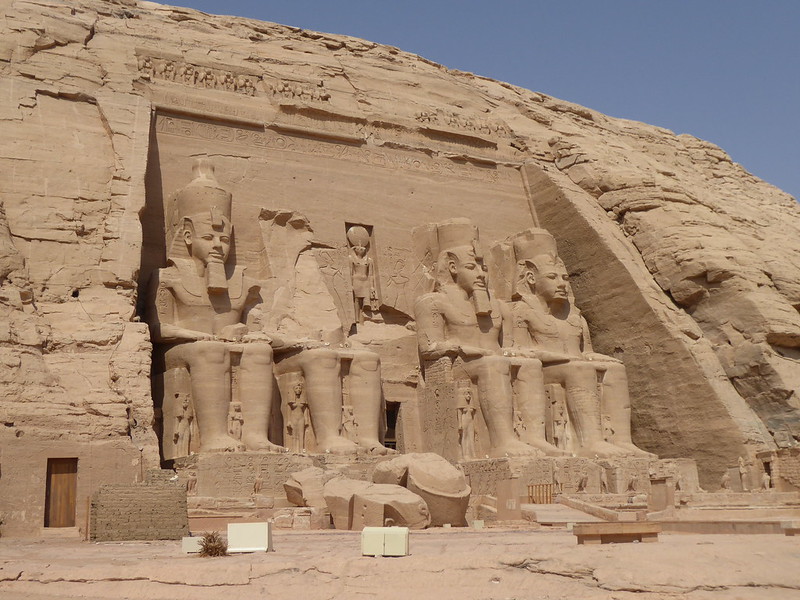Abu Simbel: A Majestic Wonder in Egyptian Sands
Abu Simbel: A Majestic Wonder in Egyptian Sands
Blog Article

Deep within the sands of southern Egypt lies Abu Simbel, a testament to the power and grandeur of the Kings. Constructed by Pharaoh Ramses II during the 13th century BC, these colossal temples are absolutely awe-inspiring, hewn directly into the cliffs and embellished with intricate sculptures and hieroglyphics. The temple complex consists of two main structures: a larger temple dedicated to Ramses II and a smaller one celebrating his beloved queen, Nefertari.
The sheer scale of Abu Simbel is impressive.
Towering over visitors are the four colossal statues of Ramses II, each reaching at over 65 feet high, their expressions etched with strength. The interiors of the temples house a wealth of ancient decorations, including depictions of battles and scenes from Ramses II's reign.
The preservation and relocation of Abu Simbel in the 1960s, because of the construction of the Aswan High Dam, is a remarkable feat of engineering and a testament to the importance of protecting ancient heritage. Today, Abu Simbel stands as a symbol of Egypt's rich history and a wonder for travelers from around the world.
A visit to Abu Simbel is an unforgettable experience that allows you to step back in time and marvel at the skill of the ancient Egyptians.
Exploring the Secrets of Abu Simbel, Egypt's Architectural Gem
Deep in the remote reaches of Egypt lies Abu Simbel, a testament to the power and grandeur of ancient Kings. This awe-inspiring complex, carved into the steep cliffs, is a masterpiece of engineering and artistry.
The two colossal temples, dedicated to the Pharaoh Ramses II, stand as silent guardians, their intricately carved facades adorned with sacred scenes and colossal statues. Inside, the enormous chambers are filled with paintings that depict triumphs, while the golden light streaming through the carefully aligned openings casts ethereal shadows, illuminating the secrets of this lost world.
A visit to Abu Simbel is a journey back in time, a chance to witness the ingenuity and creative genius of one of history's greatest civilizations.
Luxor Temple: A Testament to Ancient Egyptian Grandeur
Rising from the sands of time, Luxor Temple stands as a testament to the ancient Egyptians' architectural prowess and spiritual devotion. Its grandiose columns, intricately carved with scenes of deities and pharaohs, whispering tales of a glorious past. The temple complex, originally dedicated to the sun god Amun-Ra, showcases an array of awe-inspiring structures, including the famed Hypostyle Hall, where scores of massive pillars create a dappled ambiance.
Within its vast grounds, visitors can explore the footsteps of pharaohs who worshipped Amun-Ra here, imprinting their legacy in the very stones. Luxor Temple is more than just a collection of ancient ruins; it is a active memory of a civilization that thrived.
Embrace in the heart amidst Nubian lands, stands Simbel, Egypt.
A testament to grandeur power and architectural brilliance, this extraordinary complex enchants us straight back to the reign during Pharaoh Ramses II. Mirrored temples, carved majestically into sheer rock faces, protrude as a monumental symbol to the pharaoh's might. Visitors can explore the intricate reliefs that depict scenes about Ramses II's life and conquests.
The temples contain a wealth with historical and artistic treasures, offering a peek into the wealth of ancient Egypt. The monumental scale and the intricate carvings make Simbel an majestic experience, a journey that truly transports you to another historical epoch.
Journey Through Time at the Temples of Nubia
Venture into the ancient realm of Nubia and explore the magnificent temples that whisper tales of a bygone era. These awe-inspiring structures, constructed from sturdy sandstone, stand as testaments to the architectural skills of their creators. Through weathered walls and decipherable carvings, we can reconstruct the rich history and vibrant culture of this forgotten civilization. Each temple offers a unique glimpse into the beliefs and practices of the Nubian people, their reverence for their gods, and their mastery over the art of temple erection.
Wander through the ruins, where centuries-old stones tell stories of a glorious past. Feel the weight of history as you gaze upon the majestic obelisks and intricate reliefs that adorn these sacred spaces. Let your imagination take flight as you traverse through time, enveloped by the echoes of ancient rituals and ceremonies.
Exploring the Enigmatic Power of Abu Simbel
Abu Simbel stands as a majestic testament to the power and vision of ancient Egypt's Pharaoh Ramses II. Hewn from sheer rock face, these grand temples are not merely architectural marvels, but also potent symbols of a civilization that thrived for centuries.
The temple's positioning with the sun on specific days of the year creates an otherworldly spectacle, casting light deep within the sanctuaries and illuminating the statuesque statues of Ramses II. This cosmic precision speaks to the Egyptians' sophisticated understanding of the universe and Temples of Egypt their ability to harness its power.
Visiting Abu Simbel is a transformative experience that engulfes you in the essence of ancient Egypt. It's a testament of the enduring legacy of this culture, and its ability to captivate us even millennia later. Report this page